Hydraulic jacks are powerful tools that have revolutionized the way you lift and support heavy objects. These devices use the principles of fluid mechanics to generate force, making them important in a wide range of industries from car repair to construction. In this article, we will explore the functions, applications, and benefits of hydraulic jacks, as well as the different types available on the market.
Hydraulic jacks work based on Pascal’s principle, which states that when pressure is applied to a confined fluid, the pressure is transmitted evenly in all directions. This principle allows hydraulic jacks to lift heavy objects with relative ease. The basic components of a hydraulic jack include a reservoir, pump, valve, piston, and cylinder. When the pump starts, it forces hydraulic oil into the cylinder, which pushes the piston upward, lifting the load.
One of the main advantages of hydraulic jacks is their ability to generate large amounts of force with minimal effort. This makes them ideal for lifting heavy loads that would be impractical to lift manually. Additionally, hydraulic jacks provide stable and controlled lifting motion, ensuring the safety of the operator and the load being lifted.
Application of hydraulic jack
Hydraulic jacks are widely used in various industries due to their versatility and efficiency. In the automotive sector, hydraulic jacks are essential for lifting vehicles during maintenance and repair tasks. Whether you’re changing a tire or servicing your vehicle’s chassis, a hydraulic jack provides the necessary lift to make these tasks manageable.
In the construction industry, hydraulic jacks are used to lift and support heavy structures such as beams and columns. They are also used in bridge construction and maintenance, where the need for precise and controlled lifting is critical. Additionally, hydraulic jacks are used in industrial settings for machinery installation and maintenance, and in shipyards for lifting and positioning large components of ships.
In addition to industrial and construction applications, hydraulic jacks are also used in the aerospace industry to lift and position aircraft components during assembly and maintenance processes. Their ability to provide controlled and precise lift makes them indispensable in the field.
Types of hydraulic jacks
There are several types of hydraulic jacks, each designed for specific applications and load capacities. Some of the most common types include:
1. Bottle Jacks: These are compact portable jacks that are shaped like a bottle, hence the name. They are often used to lift vehicles and other heavy objects.
2. Floor Jack: Floor jacks are larger and sturdier than bottle jacks and are suitable for heavy lifting tasks. They are often used in auto repair shops and garages.
3. Hydraulic Cylinder Jacks: These jacks consist of a hydraulic cylinder and a piston and are used to lift and push heavy objects in industrial and construction environments.
4. Long ram jacks: Long ram jacks are designed for applications requiring longer strokes, such as lifting heavy machinery and equipment.
Advantages of hydraulic jacks
The use of hydraulic jacks brings numerous benefits to various industries. Some key advantages include:
1. High lifting capacity: Hydraulic jacks can easily lift heavy objects and are indispensable in industries that require heavy lifting.
2. Precise control: Hydraulic jacks can precisely control the lifting process, thereby achieving accurate positioning of heavy objects.
3. Safety: The stable and controlled lifting motion of a hydraulic jack improves the safety of the operator and the load being lifted.
4. Versatility: Hydraulic jacks are versatile tools that can be used in a wide range of applications, from automotive repair to construction and industrial settings.
5. Durability: A well-maintained hydraulic jack can have a long service life, providing a reliable lifting solution for years to come.
In summary, hydraulic jacks are important tools that have changed the way industries lift and support heavy objects. Their ability to generate massive lift with minimal effort, coupled with precise control and versatility, makes them valuable assets in automotive, construction, industrial and aerospace applications. Hydraulic jacks, available in different types to suit specific needs, continue to play a vital role in making lifting operations more efficient and safer.
Post time: May-29-2024

